Honeywell Smart Home Security Review: Good But Pricey
This all-in-one security system works well, but other systems offer more for less.
Why you can trust Tom's Guide

Honeywell bundled an impressive number of features into the company's crowdsourced Smart Home Security starter kit, including a security camera, smart home integration and Alexa. But it's not what Honeywell included so much as what it left out from this $450 kit that gives us pause.
This product lacks proper facial recognition features and doesn't offer professional monitoring, which makes its price too high when compared to the best DIY home security systems from Abode and SimpliSafe, which offer less expensive and more expansive starter security kits.
Design
The Honeywell Smart Home Security kit comes with a base station (sold separately, without the sensors, for $350), two entry sensors and a key-chain remote.
The base station is the main act in this security kit, and if you said it looks like a security camera plopped on to an Amazon Echo, you wouldn't be too far off. At the top is a 2-megapixel, 1080p camera with a sliding privacy shade. The bottom part of the base lights up in a variety of colors, like red to indicate it's muted and green to indicate a departure countdown (by default, this is set to 60 seconds).
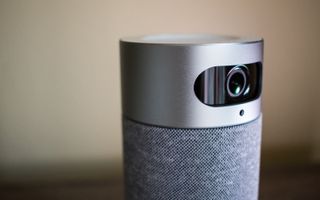
If you like to talk to your pets while you're away from home, you'll enjoy that the base station offers two-way audio. There's also an 85-decibel alarm inside, as well as a Z-Wave radio for pairing smart home accessories. And if you need to turn on your smart lights, you can command Amazon Alexa to do so through the Honeywell base station.

The entry sensors can be affixed to windows or doors, though they're more than twice the size of the 1.5-inch sensors you get from SimpliSafe's respective security kit. Once the Honeywell entry sensors are installed, their presence is very obvious. Conversely, the included key-chain remote could use a few more inches of plastic, as it's too small to be a remote and too large to fit on a bundle of keys.
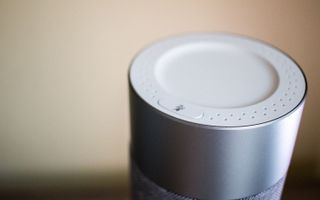
Unlike with the Abode and Nest security systems, there is no cellular backup offered on the Honeywell base station. There is a backup battery for power outages, though it lasts for only half an hour.
MORE: The Best DIY Home Security Systems
Additional Options
If you have a large house or want to add on other Honeywell-made accessories, you can purchase the sold-separately Indoor MotionViewer ($150), Outdoor MotionViewer ($200) and Indoor Motion Sensor ($50) to pair with the base station. Additional entry sensors and key-chain remotes run $40 and $30 apiece, respectively.
Setup
It took me less than 10 minutes, to set up the Honeywell Smart Home Starter Kit. Before you can even plug it in, however, you'll want to download the Honeywell Home app for your iPhone or Android device.

The app takes care of most of the configuration, including connecting the camera to Wi-Fi and pairing the different sensors. It also walks you through setting up features like geofencing, which uses your phone's location to switch between home and away mode each time you leave the house. And the app will ask you to input your Amazon credentials for Alexa access.
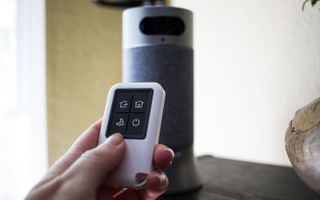
The Honeywell smart home security system also offers facial recognition features. They're free to use, unlike what you'll get with Nest security cameras, which require an annual fee. To program these features, you'll have to snap four photos of your face at different angles, which are then stored as a reference for the facial recognition software.
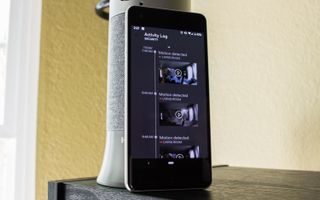
The app will allow you to schedule the facial-recognition feature to run for a maximum of only 2 hours a day, which Honeywell said should be enough for most users. You're also limited to two face profiles, which seems extremely limited for any household. The company said it's working on a subscription-based option for those who require more "faces" and longer monitoring periods.
The app will allow you to schedule the facial-recognition feature to run for a maximum of only 2 hours a day.
You won't need much hardware to set up the rest of the security kit. The entry sensors stick to the wall with strong adhesive, and the keypad remote requires the mere long-press of a few buttons to pair with the base station. If you need to add family members to the account, you can do so in the Honeywell Home app's settings panel.
Professional Monitoring
There is no professional monitoring available with the Honeywell smart home security kit, though you can get added benefits by paying a monthly membership fee. For $5 a month, or $50 a year, Honeywell offers 30 days of storage and 1,500 video clips. There's also a $15-a-month (or $150-a-year) subscription for 60 days of storage and 3,000 video clips. Each membership includes discounts on certain DIY Honeywell Home products and access to beta testing features before they're released as over-the-air updates.
MORE: Smart Home - New Products, Systems and Security
How Honeywell Smart Home Security Works
Most of the interaction with the Honeywell smart home security base station takes place through the Honeywell Home mobile app. It's here that you can pop in on the livestream from the camera; sort through the security system's notification history; or quickly switch among Home Away, and Night modes, the latter of which will trigger an alarm for the entry sensors but not for any motion.
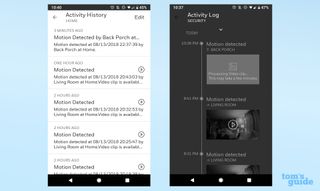
If you decide to add any additional cameras or Honeywell-branded thermostats, you can access those from the main screen of the app. If you don't usually have your phone nearby, you can use the key-chain remote to change security modes instead.

The live camera feed is great for peeking in while you're not at home, though it's a bit slow to load compared to my experience with the Nest security cameras. It takes about 3 to 5 seconds for the stream to come through, especially when using your smartphone's mobile data.
The live camera feed is great for peeking in while you're not at home.
The facial recognition feature does not work as smoothly as on the Nest IQ security cameras. I registered my face, but the Honeywell smart home security base station camera could not recognize me specifically, even as I stuck my face directly in front of the camera. It wasn't until I re-registered my face that the camera was able to accurately identify me.
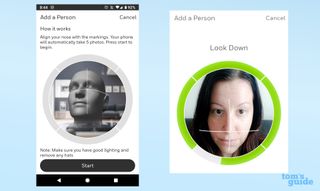
While the system is armed, an LED at the bottom of the base station will slowly pulse green. If a door is opened in the house, the base will switch to a white light and begin an accelerating 1-minute countdown. The 85-decibel alarm will sound off at the end, and while it's certainly alarming to anyone standing near it, the sound is not loud enough to attract attention from outsiders. I could barely hear the alarm over construction at my neighbor's house next door.
The 85-decibel alarm is certainly alarming to anyone standing near it, but it's not loud enough to attract attention from outsiders.
During the countdown, the Honeywell Home app on your phone will pop up a preview window of the camera feed, along with a few quick action buttons you can use to disable the alarm or call the authorities. I did not attempt the latter option, but I did call off the alarm, and the base station went silent almost immediately.
Smart Home Control
Honeywell has programmed some proprietary voice-activated security commands into the base station, which you can engage by saying, "OK, Security." When you use phrases like "I'm leaving" and "Bedtime," the base station will switch to Away and Night modes, respectively. Although the voice commands work only with this particular product, I like the user-friendly nature of the implementation. The process is approachable and helps encourage interaction with the base.
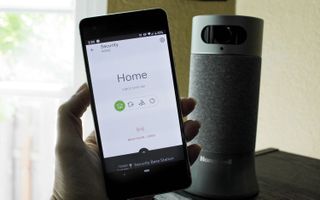
The Honeywell smart home security base station also offers Amazon Alexa capabilities, though they're limited. You can't set reminders or stream music, for example, nor are there drop-in capabilities (music streaming is on the road map, though). There is an Alexa skill available for the Honeywell smart home security system so that you can control certain smart lights, but I did not set that up. Also, I found the smart speaker part of the base station too sensitive. At one point during testing, I had a guest ask me to turn off the Honeywell's microphone because it kept lighting up, mistakenly thinking that we were trying to use Alexa.
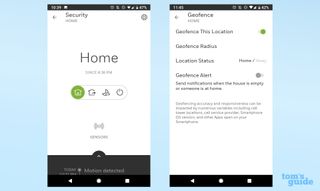
The base station has Z-Wave inside so that you can use it as a smart hub of sorts for home automation with compatible smart lights and dimmers. Pairing is done entirely through the Honeywell Home mobile app, though you can use Google Assistant commands with any of the devices you pair through the Honeywell base station. However, most of the popular brands, like Philips Hue smart lights, use Zigbee not Z-Wave.
Bottom Line
For do-it-yourself smart home security systems to be worthy buys, they have to be easy to set up and user-friendly. The Honeywell Smart Home Security starter kit certainly meets that criteria, but it simply costs too much for all the other stuff that's bundled in. The security camera works fine, but its facial recognition features are subpar for a device in this category. And its Alexa functionality doesn't even work with all the same commands as a standard Echo speaker.
If you're looking to set up your own smart home security system, the Abode Essentials Starter Kit ($280) is a considerably cheaper choice. It has both Zigbee and Z-Wave integration, so you can pair any compatible third-party smart home accessory and a louder alarm that your neighbors could hear over hammering. You could also tack on a $50 Echo Dot and a $50 EzViz Mini O camera, and the final price would still be less than the $450 for the Honeywell smart home security kit.
Credit: Tom's Guide
Sign up to get the BEST of Tom’s Guide direct to your inbox.
Upgrade your life with a daily dose of the biggest tech news, lifestyle hacks and our curated analysis. Be the first to know about cutting-edge gadgets and the hottest deals.
Florence Ion has worked for Ars Technica, PC World, and Android Central, before freelancing for several tech publications, including Tom's Guide. She's currently a staff writer at Gizmodo, and you can watch her as the host of All About Android on the This Week in Tech network.
